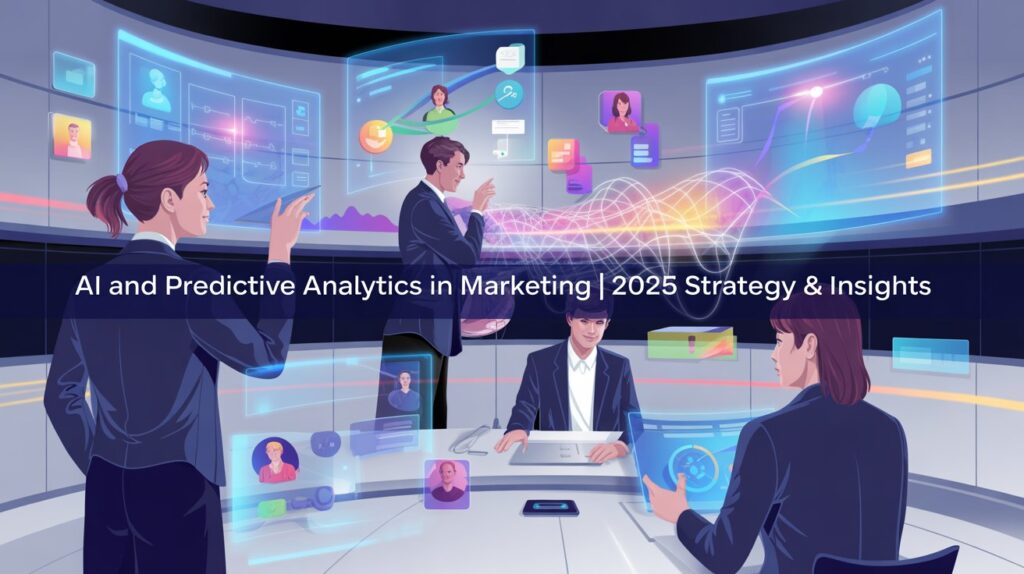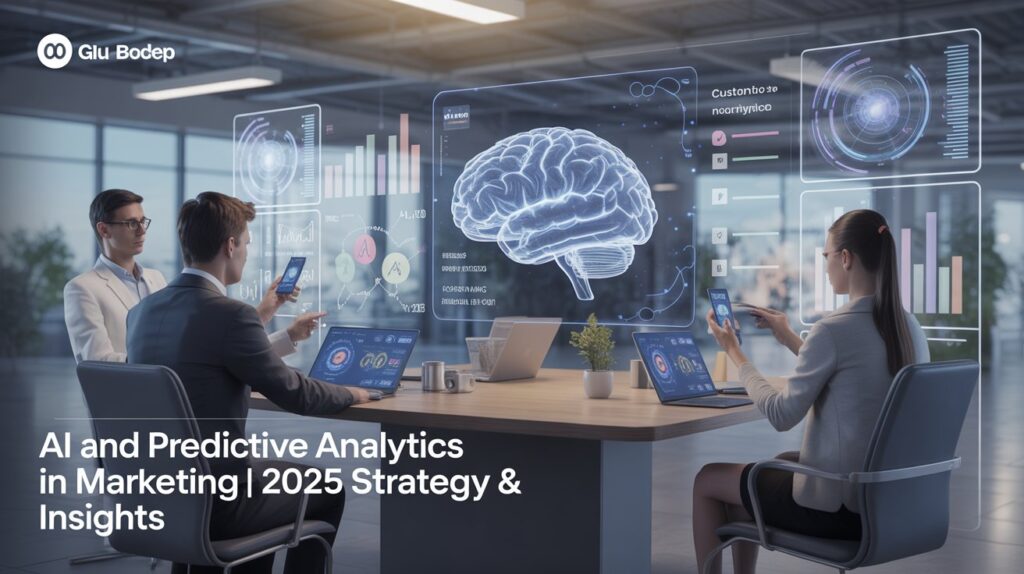In today’s competitive digital landscape, marketers no longer rely solely on intuition or historical data. The convergence of AI and Predictive Analytics in Marketing has fundamentally transformed how businesses understand their audiences, anticipate behavior, and personalize customer experiences.
Predictive analytics uses data, statistical algorithms, and machine learning to identify the likelihood of future outcomes based on historical information. When powered by artificial intelligence (AI), these insights become sharper, faster, and actionable at scale—allowing companies to predict customer needs before they even arise.
This article provides a comprehensive guide to how AI and predictive analytics are reshaping marketing strategies, the key tools and models driving success, and practical ways to implement them in 2025 and beyond.
What Is Predictive Analytics in Marketing?
Predictive analytics in marketing involves using historical data, AI algorithms, and statistical models to forecast future customer actions. The goal is to identify patterns that predict key outcomes such as purchase intent, churn probability, or campaign effectiveness.
For instance, if a company analyzes past data and identifies that customers who download a free resource and visit a pricing page twice within a week are 70% likely to convert, that insight becomes a powerful marketing signal. Predictive analytics automates the discovery of such patterns, helping teams make smarter, faster decisions.
When integrated with AI technologies—like natural language processing, machine learning, and deep learning—predictive models can process massive amounts of data in real time, enabling hyper-personalized campaigns and more efficient budget allocation.
Why AI and Predictive Analytics Matter in Modern Marketing
The days of one-size-fits-all campaigns are over. Customers expect personalized, timely experiences—and AI-powered analytics make that possible.
1. Data-Driven Decision-Making
AI algorithms analyze large datasets from multiple sources—social media, CRM, website behavior, email engagement—to reveal actionable trends. Marketers can then base their strategies on evidence, not guesswork.
2. Enhanced Customer Targeting
Predictive models segment audiences dynamically based on behavior, not just demographics. This means ads, emails, and recommendations reach the right people at the right moment, increasing engagement and conversion rates.
3. Cost Efficiency and ROI
AI helps marketers allocate budgets intelligently by predicting which channels, messages, or customer segments will yield the best results. This reduces wasted spend and boosts overall return on investment (ROI).
4. Real-Time Personalization
Machine learning allows businesses to deliver personalized offers instantly—based on browsing history, intent signals, and contextual data—dramatically improving customer satisfaction.
Key Use Cases of AI and Predictive Analytics in Marketing
AI-driven predictive analytics can be applied across every stage of the marketing funnel. Here are some of the most impactful use cases:
1. Lead Scoring and Prioritization
Predictive lead scoring models analyze customer interactions to identify which prospects are most likely to convert. Instead of relying on manual scoring or intuition, marketers can focus their efforts on high-potential leads, improving sales efficiency and closing rates.
2. Customer Churn Prediction
By examining behavioral data such as declining engagement, negative feedback, or reduced spending, AI models can predict when a customer is at risk of leaving. This allows businesses to intervene early with personalized retention offers or re-engagement campaigns.
3. Customer Lifetime Value (CLV) Forecasting
Predictive models can estimate how much revenue a customer will generate over time. This helps marketers tailor loyalty programs and prioritize high-value customers for special offers or premium experiences.
4. Product Recommendations
AI systems analyze past purchases and browsing patterns to recommend relevant products. Companies like Amazon and Netflix have used this strategy to increase sales and engagement significantly.
5. Campaign Optimization
Predictive analytics helps determine which marketing messages, visuals, or channels will perform best before a campaign even launches. Marketers can simulate outcomes, adjust budgets, and optimize creatives for higher returns.
6. Dynamic Pricing and Promotions
AI can forecast demand and customer sensitivity to price changes, allowing companies to adjust pricing or promotions in real time for maximum profitability.
The Data Behind Predictive Marketing
Data quality is the foundation of any successful predictive model. To leverage AI and predictive analytics effectively, marketers must gather and organize clean, comprehensive data from multiple sources.
1. Key Data Sources
-
CRM systems – for customer demographics, purchase history, and interactions
-
Web analytics tools – for user behavior, session times, and engagement metrics
-
Social media platforms – for sentiment analysis and influencer tracking
-
Email and ad platforms – for campaign engagement metrics
-
Transaction databases – for purchase frequency and basket analysis
2. Data Preparation and Feature Engineering
AI models rely on structured data to learn effectively. Marketers must:
-
Clean and normalize datasets to remove duplicates and inconsistencies.
-
Create meaningful “features” (variables) such as session duration, email open rate, or days since last purchase.
-
Label data with desired outcomes—e.g., “converted” or “did not convert”—for supervised learning.
3. Privacy and Compliance
Respecting user privacy is essential. Always comply with regulations such as GDPR and CCPA, and implement anonymization or consent-based data collection methods.
Common Predictive Models Used in Marketing
AI and predictive analytics employ several modeling techniques to forecast outcomes. Understanding these can help marketers choose the right model for each use case.
1. Regression Analysis
Used to predict continuous outcomes (e.g., revenue growth, purchase amount). It establishes relationships between variables such as advertising spend and sales.
2. Classification Models
These categorize customers into groups—like “likely to convert” vs. “unlikely to convert.” Logistic regression and decision trees are commonly used here.
3. Clustering Algorithms
Unsupervised learning methods like K-Means group customers with similar behaviors or attributes, ideal for audience segmentation and targeted marketing.
4. Time Series Forecasting
Analyzes trends over time—useful for predicting sales cycles, seasonal demand, or campaign performance trends.
5. Neural Networks
Deep learning models can identify complex patterns in data, improving accuracy in recommendations and personalization systems.
How to Implement AI and Predictive Analytics in Your Marketing Strategy
Integrating predictive analytics into your marketing workflow doesn’t happen overnight. Here’s a structured approach:
Step 1: Define Clear Objectives
Start by identifying measurable goals—such as improving lead conversion by 20% or reducing churn by 10%. This clarity ensures your models are built with purpose.
Step 2: Collect and Integrate Data
Aggregate customer data from all touchpoints. Use data management platforms (DMPs) or customer data platforms (CDPs) to unify and clean your datasets.
Step 3: Choose the Right Tools
Popular predictive analytics and AI tools include:
-
Google Cloud AI Platform
-
Salesforce Einstein
-
IBM Watson Marketing
-
Adobe Sensei
-
HubSpot Predictive Lead Scoring
Select tools that integrate seamlessly with your existing CRM or automation stack.
Step 4: Build and Train Models
Work with data scientists or AI specialists to create predictive models aligned with your objectives. Test their accuracy using historical data and adjust variables as needed.
Step 5: Integrate Insights into Campaigns
Use model outputs to drive decisions in real time—adjust targeting, personalize content, or trigger automated workflows based on predictive scores.
Step 6: Measure and Optimize
Continuously track model performance using key metrics such as precision, recall, and lift. Periodically retrain models to maintain accuracy as market conditions change.
Challenges in Predictive Marketing
While the potential is vast, marketers must navigate several challenges when adopting AI-driven analytics.
1. Data Quality and Accessibility
Incomplete or inconsistent data can lead to inaccurate predictions. Regular audits and robust data governance are essential.
2. Lack of Expertise
Building predictive models requires specialized skills. Many companies bridge this gap by partnering with analytics firms or leveraging no-code AI tools.
3. Algorithmic Bias
AI models can unintentionally perpetuate bias if trained on skewed data. Transparency and diverse data inputs help mitigate this risk.
4. Integration Complexity
Connecting AI tools with marketing platforms, CRMs, and data warehouses can be technically demanding. Use APIs and standardized data pipelines for smooth integration.
Measuring Success: Metrics That Matter
To ensure predictive marketing initiatives deliver measurable value, track metrics that link directly to business outcomes:
-
Conversion Rate Lift: Improvement in conversions compared to non-AI campaigns.
-
Customer Retention Rate: Reduction in churn following predictive interventions.
-
Marketing ROI: Incremental revenue vs. investment in predictive tools.
-
Engagement Metrics: Increases in open rates, click-through rates, and time on site.
-
Model Accuracy: Precision, recall, and F1 scores indicate how well predictions match real outcomes.
The Future of AI and Predictive Analytics in Marketing
Looking ahead, AI’s role in marketing will continue to expand as automation, personalization, and predictive modeling become standard practice. Emerging trends include:
-
Generative AI for Content Personalization: Creating adaptive ad creatives and messages tailored to individual user profiles.
-
Predictive Customer Journeys: Mapping end-to-end customer paths using AI to anticipate next actions.
-
Voice and Conversational AI: Predicting user intent in real time through speech and chat interactions.
-
Integration with IoT and Edge Devices: Delivering predictive insights instantly through smart environments and connected experiences.
The future will favor marketers who combine creativity with data-driven intelligence—using AI not to replace intuition, but to refine it.
FAQs
1. What is the role of AI in predictive analytics?
AI enhances predictive analytics by automating data analysis, detecting complex patterns, and providing faster, more accurate predictions than manual methods.
2. How can small businesses use AI and predictive analytics?
Small businesses can start with simple tools—like built-in CRM analytics or predictive email scoring—to personalize campaigns and improve lead targeting.
3. Is predictive marketing ethical?
Yes, when used responsibly. Ethical predictive marketing requires transparency, data consent, and adherence to privacy laws.
4. How often should predictive models be updated?
Models should be retrained quarterly or whenever significant market, product, or audience behavior changes occur.
5. What’s the biggest advantage of predictive analytics for marketers?
The ability to anticipate customer behavior and act proactively—leading to smarter campaigns, higher ROI, and stronger customer relationships.
Conclusion
The integration of AI and Predictive Analytics in Marketing is redefining how organizations attract, engage, and retain customers. By leveraging data-driven insights and automation, marketers can make smarter decisions, create hyper-personalized experiences, and maximize ROI.
As we move further into 2025, predictive analytics will no longer be optional—it will be a cornerstone of every high-performing marketing strategy. Brands that embrace AI-driven foresight today will be tomorrow’s leaders in customer engagement and innovation.








